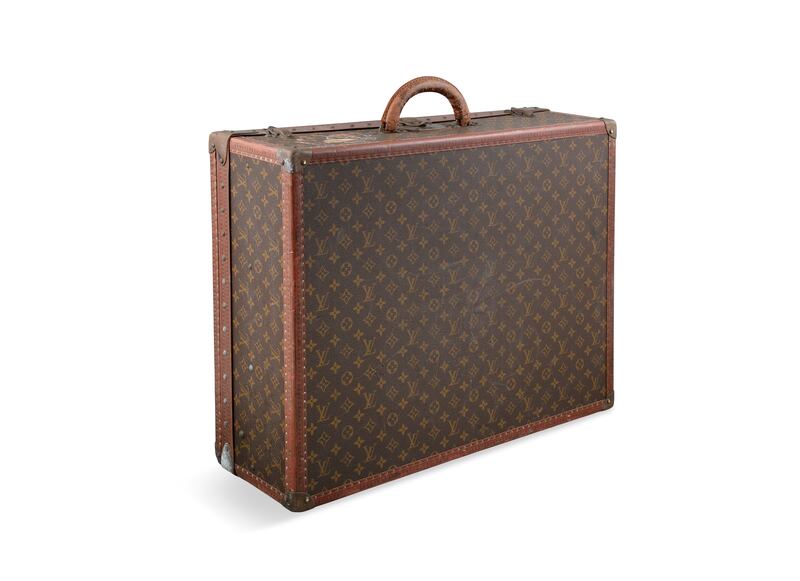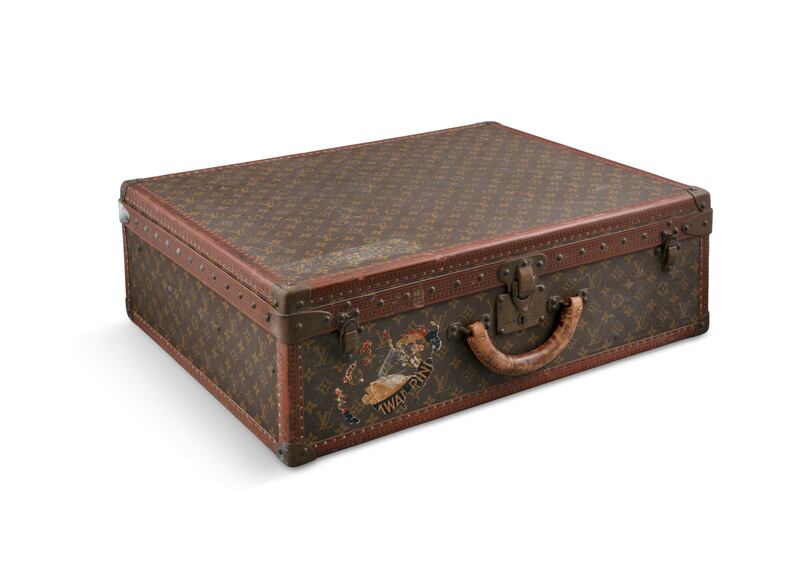Hefty, impractical, costly and absolutely dripping with glamour, the steamer trunk is having a moment. Perhaps they never really went away.
First appearing in the 1870s, these flat-top boxes were invented by a young French carpenter who went by the name of Louis Vuitton. Having apprenticed as a box maker, Vuitton made luggage stackable and added waterproof canvas, announcing in one of his first advertising posters: “Securely packs the most fragile objects. Specialising in packing fashions.”
Vuitton might have based his claims on packing away your fashionable items, but his luggage soon became the height of fashion itself, not least because he used eye-catching fabrics, from the red stripes of the 1870s to the Damier (checkerboard) patterns which appeared in 1888. The LV monogram print, for which the brand is most famous, was introduced by Vuitton’s son, Georges, and was copyrighted in 1905.
As with Burberry, that monogram is today a bit of a double-edged sword. Brand new LV-logoed luggage can appear, how shall we say it tactfully, a little loudly bling, nudging perhaps at the outer reaches of trashy? Far better to adopt the appearance of old money by acquiring your pieces at auction, pre-patinated by previous glamorous owners. You’ll find two at the Adam’s At Home Sale, taking place on June 14. More suitcase than trunk, Lot 10 dates from the mid-20th century and comes with the original sales label, with serial number, and price — then $429 (€400). Today it has an estimate of €1,500-€2,000.
READ MORE



A second Vuitton travel case is less recognisable, not least because its unmonogrammed surface comes plastered with travel stickers and tags, from spots ranging from the exotic to the more domestic “Inisfallen Way”. With an estimate of €500-€800, you’re unlikely to be chucking it, or its sister lot, into the care of the airport baggage handlers. Today these items are far more likely to appear stacked as vibey side tables, or at the foot of beds, containing your spare smalls.

The history of invention tends to be linked to necessity. The now-ubiquitous wheelie suitcase (patented as late as 1970) only took off when mass travel became the norm, and people started having to actually carry their own stuff. That said, Lonely Planet’s How to Pack for Any Trip, published in 2016, notes the Knights Templar used wheeled cases to transport their armour during the Crusades, all the way back in 1153.
The word “luggage” comes from the idea of lugging around, and steamer trunks date from a time when anyone who could afford to travel for leisure certainly wouldn’t have lifted a finger when it came to transporting their necessities. In Jules Verne’s Around the World in Eighty Days (published in 1873), when Phileas Fogg astounds his servant, Passepartout, declaring, “We’ll have no trunks; only a carpet bag” on their epic journey, he is declaring the trip will be a DIY adventure where anything can happen — and they’ll be ready for it when it does. The carpet bag carried by Fogg, as played by David Niven in the 1956 film version of the book, came up for auction with Sheppard’s in 2019. Carrying an estimate of €800-€1,200; it sold for €1,600.
Vintage trunks are highly collectable. A Louis Vuitton cabin trunk sold at Sotheby’s in 2019 for €23,350. The price tag for a new one is pretty hefty too: the Malle Haute comes in at €45,000, and the Courier Lozine at €38,000.
Moving with the times, if money is no object, and a certain kind of style is your thing, you can always splash out on a DJ Trunk. The Malle DJ comes equipped with a foldable table, storage drawers and even your cables are covered in monogrammed canvas. Then, what about the made-to-order Sneaker Trunk that will house up to 14 pairs of kicks? Given that a pair of Michael Jordan Nikes sold at Sotheby’s in October of last year for a record $1.47 million, and a pair of Kanye West Nikes went for $1.8 million, also with Sotheby’s (although this time in a private sale in April 2021), housing your runners in a suitably august receptacle might start to make sense.
Asian art
Looking ahead, Adam’s is holding a pair of Asian art auctions on June 28th and 29th, with fine arts from China and the Himalayas going first, followed by pieces from Vietnam, Indochina and Japan. If you happen to be in Paris this weekend, lots are being previewed at the Pagoda Fair (pagodaparis.com), as part of the Paris Asia Week. Viewing also makes for a marvellous excuse to visit the Chinese-inspired 1920s pagoda, built for the late (and controversial) Chinese dealer C.T. Loo, in the eighth arrondissement, where pieces from the Adams sale are on display, until June 12th.

Highlights include a six-fold lacquer screen dating from 1943 (€200,000-€400,000) by Vietnamese artist, Le Quoc Loc; French artist Alix Aymé's lacquer panel of a girl with flowers (€100,000-€200,0000); and a jade lotus cup (€15,000-€30,000).


















